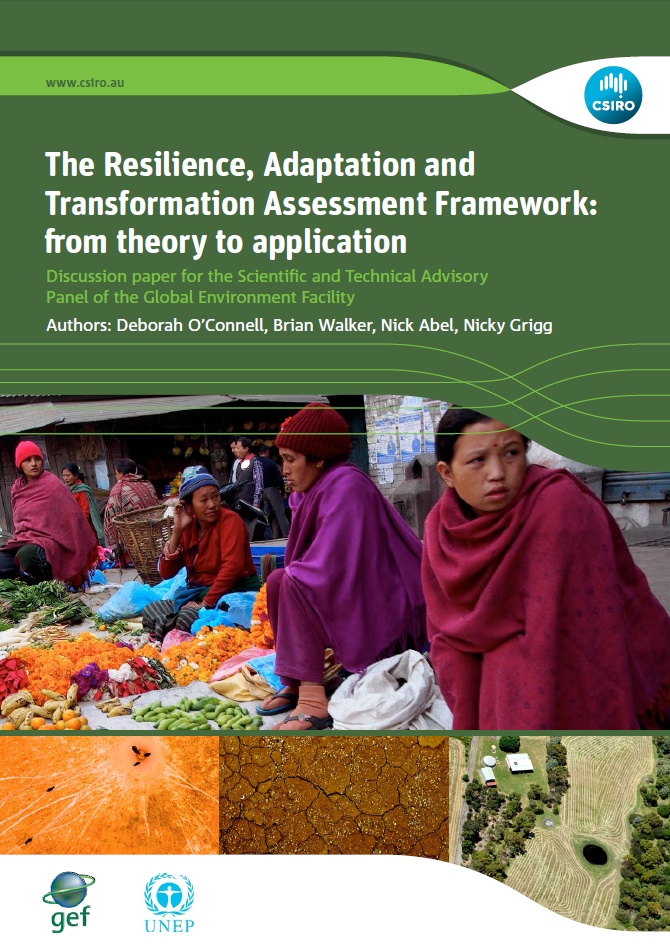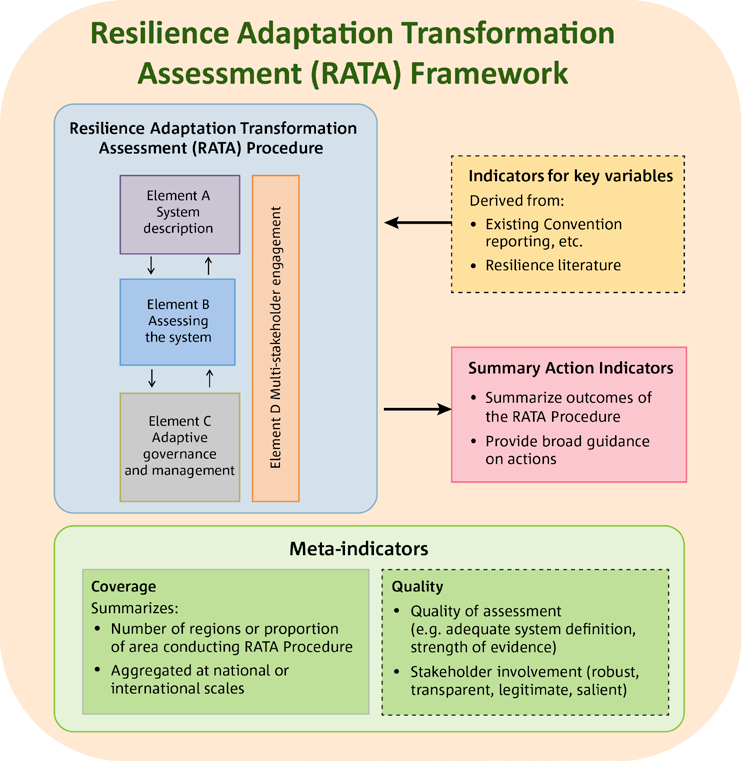Dissecting the Resilience Adaptation Transformation Assessment and Learning Framework (RATALF)
The concepts of "resilience", "adaptation" and "transformation" have captured the attention of the global policy community, and are being translated into aspirational goals that guide policy development. Understanding resilience, adaptation and transformation of agro-ecosystems is critical to meeting the Sustainable Development Goals related to food security, land degradation neutrality and climate change adaptation.
 That, in short, describes the overarching rationale for the development of the Resilience Adaptation Transformation Assessment and Learning Framework (RATALF), which was commissioned by the Scientific and Technical Advisory Panel (STAP) of the Global Environment Facility (GEF).
That, in short, describes the overarching rationale for the development of the Resilience Adaptation Transformation Assessment and Learning Framework (RATALF), which was commissioned by the Scientific and Technical Advisory Panel (STAP) of the Global Environment Facility (GEF).
The RATALF is intended to meet common objectives across the three Rio Conventions (the United Nations Convention to Combat Desertification, UNCCD; the Convention on Biological Diversity, CBD, and the United Nations Framework Convention on Climate Change, UNFCCC), the emerging Sustainable development Goals (SDGs), the GEF land degradation strategy, and GEF's program on "Sustainability and Resilience for food security in Sub-Saharan Africa". As the authors put forward; "The development of this framework to assess resilience, adaptation and transformation represents an opportunity to align approaches and monitoring towards common objectives, contribute to integrated strategies, and pursue synergies in reporting between the Conventions."
Resilience
Resilience is a bit of complicated concept, that is – as are many concepts related to climate change – open for academic debate as to what it entails or aims to capture. In a Synthesis Report of Adaptation and Resilience M&E Frameworks and Tools the focus of the authors was on how M&E frameworks approached adaptation and resilience, while in a (to be released June 15) Climate Change Adaptation Indicator Study Report by Climate-Eval the focus is on different indicator classifications for adaptation and resilience, and on principles for developing and selecting indicators. In both cases the authors, and the tools and frameworks discussed, depart from the idea that resilience is inherently a positive development.
Annette Cowie points out in her blog that this is not always the case, and concludes that it is unlikely that we will agree on a common definition. Instead, we need to accept that people define resilience differently, and that these differences do matter. It is the responsibility of the user of the term to ensure that (s)he is aware of the different ways other people use the term, to make sure the usage by the audience is being addressed, and to spell out his/her own definition at the beginning of the interaction.
RAT: Resilience Adaptation and Transformation
Following Cowie's line of thought that resilience is not necessarily a desirable attribute we shouldn't be looking at resilience as end goal, but instead apply resilience concepts to advance sustainable development goals. The Resilience, Adaptation and Transformation Assessment and Learning Framework (RATALF) can help us do this, given it seeks to build or adapt system properties (such as resilience) to meet normatively defined sustainability goals.
The publication starts in Chapter 1 with discussing the differences between societal and technical use of the key concepts "resilience", "adaptation", "transformation" and "sustainability". Where society frames these concepts invariably in a positive light - as desirable attributes, or as aspirational goals - the scientific use of terms such as resilience, adaptation and transformation must be neutral and objective. Chapter 3 ends with a useful summary of ten important things to keep in mind about resilience, adaptation and transformation when developing a theory.
Indicator Development
The RATALF approach provides a snapshot in Chapter 2 of the current approaches to indicators in global policy instruments, as well as a brief review of current "resilience indicator" literature. A strong theme of "learning" is apparent in both the recommended indicators themselves, and in the approach used to elicit appropriate resilience indicators. The authors come to the conclusion that "indicators covered in the literature will be useful in supporting a resilience assessment; however no single indicator will provide any useful information about resilience, adaptation or transformation without further analysis." They then provide some guidance on indicator development and selection, as will be the main focus in the upcoming Climate Change Adaptation Indicator Study Report by Climate-Eval.
AF: Assessment Framework
You might wonder, "What happened to the L (learning)?" Not to worry, after the theoretical development of the framework in Chapter 4, the learning will get ample attention and it is an integral part of the RATA framework.
The Resilience, Adaptation and Transformation Assessment Procedure (RATA Procedure) is a step by step iterative method for assessment conducted at the focal scale, ideally with multi-stakeholder engagement.
The framework and related procedure lead users through a process to:
- Explore and describe aspirational sustainability goals, and understand how the system functions.
- Identify the values and outputs that people expect or desire from the system now and in the future, and the drivers that affect these.
- Identify a small set of controlling variables critical to the function of the system. This will include biophysical components, governance, social interactions, and cross-scale interactions
- Determine the need and options, for adapting or transforming the system, if this is necessary to achieve the sustainability goals, and adaptation pathways to avoid undesirable futures.
The results of the assessment procedure are captured by summary action indicators that provide broad guidance on the types of actions that may be appropriate to enhance resilience, or to support transformation. Application of the framework is proposed as a process indicator: Meta-indicators provide a way to consistently report the coverage, quality, maturity, progress and relevant actions based on individual assessments.
L: Learning
Element C of the Framework is where the learning is situated, though learning should be seen as an overarching element of the adaptive management approach and iterative nature of the framework. RATA is to be embedded in an adaptive management cycle, in which outcomes of interventions are posed as hypotheses to be tested, so that as the outcomes unfold this ensures a learning process of how the agro-ecosystem functions. This type of information is fed back to the multi-stakeholder engagement element for broader learning.
The RATA Framework enables mutual learning, fostering common understanding across stakeholders of different perspectives, interests and visions for their system, and developing narratives that provide meaningful interpretations of existing knowledge, datasets and indicators. The iterative nature of the framework and its emphasis on learning gives it some self-correcting capacity and scope for novelty.
Concluding
The authors conclude that the dynamic concepts upon which resilience, adaptation (and adaptive capacity) and transformation (and transformability) are founded, are not meaningfully expressed or interpreted with simple 'metric' types of indicators in the same way as, for example, "land cover" or "population growth rates". The flexible, iterative RATALF assessment procedure has potential for being useful to local stakeholders.
The most prominent weakness of the RATALF is, in some ways, a consequence of one of its strengths. Its flexibility and utility across a range of contexts is accompanied by a high level of subjectivity in how it is applied. This is a strength as it enables participation and use across a wide range of settings, but it comes with a cost in that it limits the ability to compare across systems.
Resilience is not a normative concept (that is, it requires no value judgments claiming what is good and bad, or right or wrong) if departing from the idea that resilience is a system property. However, core aspects of the application of the concept within the RATALF are inherently normative judgments, including the choice of focal scale and how you frame what is in or out of the agro-ecosystem. For that reason the authors stress the need for multi-stakeholder engagement, inclusive adaptive management approaches and meta-indicators of the quality of assessment.
(two case studies and summary reports can also be accessed through this link)




